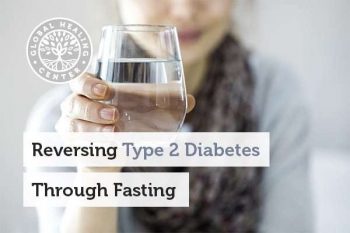November 27th, 2017
Guest writer for Wake Up World
Type 2 diabetes, sometimes referred to as adult-onset diabetes, doesn’t have to be permanent. Fasting and calorie restriction can help you get control of your blood sugar, lower your blood pressure, and even help reverse type 2 diabetes. But, before we get into how fasting can undo the damage of type 2 diabetes, we first need to understand how type 2 diabetes affects the body.
How Does Type 2 Diabetes Develop?
Diabetes develops when fat accumulates in areas of the body that shouldn’t accumulate fat. It all starts with an abundance of fat in your muscle tissue. Typically this is caused by a family history, poor diet, or sedentary lifestyle. This fat is called intramuscular fat. It’s like the marbling on a steak, only it’s inside your muscles, and it causes insulin resistance — the characteristic that distinguishes type 1 diabetes from type 2.[1, 2] Even worse, intramuscular fat causes muscles to produce toxic fat metabolites like ceramide and diacylglycerol (DAG). These toxins also contribute to insulin resistance.[3]
[pro_ad_display_adzone id=”110028″]
High Insulin Levels Lead to a Fatty Liver
When blood sugar is high, the pancreas produces insulin to lower blood sugar. However, insulin resistance causes the liver to stop responding to insulin.[4, 5] In fact, the liver keeps producing sugar despite a high level of sugar in the blood. Consuming food that’s high in sugar is like throwing gas on the fire, and the abundance of sugar is converted to fat and stored in the liver.[4]
When the liver accumulates fat, non-alcoholic fatty liver disease (NAFLD) can develop. When non-alcoholic fatty liver disease is present, the liver releases fat into the bloodstream where it’s distributed to other organs and they, just like the liver, stop responding to insulin. Especially affected is the pancreas.[5]
Fat Cripples Pancreatic Function
As fat builds up in the pancreas, its function is compromised. Since the pancreas is responsible for producing insulin, this is a major issue. Predictably, insulin production drops. Reducing body fat can help normalize blood sugar, but a lot of people begin insulin injections instead. Insulin injections help in the short-term, but also increase fat formation throughout the body, including the liver and pancreas, which leads to other health issues.[6] Fortunately, there is a better way.
Reversing Type 2 Diabetes Through Fasting
For almost 150 years, we’ve known that fasting has serious benefits for those with diabetes. In the 1870’s, Dr. Appollinaire Bouchardet, an expert on diabetes during his time, noticed that fasting produced positive results for his diabetic patients.[7] Over 100 years ago, Dr. Elliott Joslin published research suggesting that fasting could reverse diabetes.[8] They were among the first to realize that fasting detoxes your tissues and organs of fatty deposits.
Even if someone has had type 2 diabetes for a long time, the results begin almost immediately. If you can start metabolizing the fat in your organs, you can restore insulin sensitivity. And once you restore insulin sensitivity, you can get your blood sugar back on track.[7, 9]
Related reading: 20 Health Benefits of Fasting for Whole Body Wellness
Are There Possible Complications?
Fasting with type 2 diabetes comes with a few potential health consequences, which is why you should only begin a fasting regimen under the watchful eye of a certified health professional who has experience and expertise with helping diabetics through this process. Ideally, have your blood tested throughout the day to monitor your blood composition and overall health. Again, if you have diabetes, do not fast without careful, attentive supervision from qualified and experienced health care professionals.
Fasting vs. Bariatric Surgery
Fasting works similar to bariatric surgery, a gastric surgery that effectively reduces the size of your stomach. One study found that bariatric surgery helped 73% of participants go into diabetic remission.[10] This kind of surgery, however, is dangerous — both the surgery itself and managing nutrition afterward. There’s the additional consequence of forever having a stomach that’s the size of a shot glass and the difficulties that come with it.[11]
Instead of going the extreme route with invasive surgery, simply adopt the post-bariatric surgery eating philosophy. After seven days of reduced calorie intake (about 500-600 calories a day), fasting glucose normalizes. After two months on this diet, your pancreas can start producing a normal level of insulin to control blood sugar.[12, 13]
Reversing Pancreatic Damage
In the last few years, researchers have found that reversing pancreatic damage is possible. Once you clean out the fat, the insulin-producing cells start pumping out insulin again.[6] Fasting can undo the damage to your liver and pancreas to the point that they begin to function normally again.[14]
Because it takes a few months to detox your organs of accumulated fat, intermittent fasting is the way to go. With a fasting diet, you can sustain the fast long enough to get rid of the excess fat deposits that lead to type 2 diabetes. Monitor your blood sugar and blood pressure. Break your fast if your blood sugar exceeds 300 mg/dl or drops below 70 mg/dl.
Related reading: The Stages of Fasting: What Happens to Your Body When You Fast?
A reduced-calorie plant-based diet may also help repair the damage from diabetes. Remarkably, one study found that a well-planned vegan diet can lower insulin dependence by over 60% in just two weeks — without losing any weight.[15]
Overcoming Diabetes
Small changes lead to small improvements, moderate changes yield moderate improvements, but significant changes lead to extraordinary results. Do what’s right for your body. Follow a healthy diet to lead a healthy life. Cut out or reduce refined sugar, starches, and meat and cheese — all of which are consistently shown to promote diabetes.[16, 17, 18]
You can restore your health if you dare to try, and have the willpower to stick with it — and I am confident that you do.
Have you tried fasting to reverse your diabetes? Tell us about your experience in the comments below, or join the conversation on Facebook!
References:
- Kraegen, E.W., Cooney G.J. “Free fatty acids and skeletal muscle insulin resistance.” Curr Opin Lipidol. 2008 Jun;19(3):235-41. Web. 21 June 2017.
- Rachek, L.I. “Free fatty acids and skeletal muscle insulin resistance.” Prog Mol Biol Transl Sci. 2014;121:267-92. Web. 21 June 2017.
- Consitt, Leslie A., Bell, Jill A., and Houmard, Joseph A. “Intramuscular Lipid Metabolism, Insulin Action and Obesity.” IUBMB life 61.1 (2009): 47–55. PMC. Web. 21 June 2017.
- Sanders, Francis W.B., Griffin, Julian L. “De novo lipogenesis in the liver in health and disease: more than just a shunting yard for glucose.” Biol Rev Camb Philos Soc. 2016 May; 91(2): 452–468. Web. 21 June 2017.
- Bugianesi, E., Moscatiello, S., Ciaravella, M.F., Marchesini, G. “Insulin resistance in nonalcoholic fatty liver disease.” Curr Pharm Des. 2010 Jun;16(17):1941-51. Web. 21 June 2017.
- Taylor, R. “Banting Memorial Lecture 2012 Reversing the Twin Cycles of Type 2 Diabetes.” Diabetic Medicine 30.3 (2013): 267–275. PMC. Web. 21 June 2017.
- Steven, S., Lim, E.L., Taylor, R. “Dietary reversal of Type 2 diabetes motivated by research knowledge.” Diabetic Medicine. 10 February 2010. Web. 21 June 2017.
- Joslin, Elliott P. “The Treatment of Diabetes Mellitus.” Canadian Medical Association Journal 6.8 (1916): 673–684. Web. 21 June 2017.
- Santomauro A.T., et al. “Overnight lowering of free fatty acids with Acipimox improves insulin resistance and glucose tolerance in obese diabetic and nondiabetic subjects.” Diabetes. 1999 Sep;48(9):1836-41. Web. 21 June 2017.
- Dixon J.B., et al. “Adjustable Gastric Banding and Conventional Therapy for Type 2 DiabetesA Randomized Controlled Trial.” JAMA. 2008;299(3):316-323. Web. 21 June 2017.
- “Bariatric Surgery.” National Institute of Diabetes and Digestive and Kidney Diseases, U.S. Department of Health and Human Services. Accessed 21 June 2017.
- Taylor, Roy. “Type 2 Diabetes: Etiology and Reversibility.” Diabetes Care, Volume 36, April 2013. Web. 21 June 2017.
- “Fasting diet may help regenerate a diabetic pancreas – National Library of Medicine – PubMed Health.” National Center for Biotechnology Information. U.S. National Library of Medicine, n.d. Web. 21 June 2017.
- Lim, E.L. “Reversal of type 2 diabetes: normalisation of beta cell function in association with decreased pancreas and liver triacylglycerol.” Diabetologia. 2011 Oct; 54 (10): 2506-14.Web. 21 June 2017.
- Anderson, J.W., Ward, K. “High-carbohydrate, high-fiber diets for insulin-treated men with diabetes mellitus.” Am J Clin Nutr. 1979 Nov;32(11):2312-21. Web. 21 June 2017.
- Pan, An, et al. “Red meat consumption and risk of type 2 diabetes: 3 cohorts of US adults and an updated meta-analysis.” Am J Clin Nutr. 2011 Aug, 10. 94(4): 1088-1096. Web. 21 June 2017.
- Barnard, Neal, Susan Levin, and Caroline Trapp. “Meat Consumption as a Risk Factor for Type 2 Diabetes.” Nutrients 6.2 (2014): 897–910. PMC. Web. 21 June 2017.
- Vlassara, H., et al. “Inflammatory mediators are induced by dietary glycotoxins, a major risk factor for diabetic angiopathy.” Proc Natl Acad Sci U S A. 2002 Nov 26;99(24):15596-601. Web. 21 June 2017.
Recommended articles by Dr. Edward Group:
- The 9 Best Fermented Foods for Your Gut
- 14 Foods that Cleanse the Liver
- Top 5 Foods for the Pineal Gland
- 6 Things You Must Know About Colloidal Silver
- The Importance of a Kidney Cleansing Diet
- The 9 Best Herbs for Lung Cleansing and Respiratory Support
- 7 Best Foods to Support Kidney Function
- Lung Cleansing With Peppermint Oil
- 20 Health Benefits of Fasting for Whole Body Wellness
- How Fluoride Damages Pineal Gland Health
- How Does the Alkaline Diet Affect Gut Health?
- The Stages of Fasting: What Happens to Your Body When You Fast?
About the author:
 Dr. Edward F. Group III (DC, ND, DACBN, DCBCN, DABFM) founded Global Healing Center in 1998 and is currently the Chief Executive Officer. Heading up the research and development team, Dr. Group assumes a hands-on approach in producing new and advanced degenerative disease products and information.
Dr. Edward F. Group III (DC, ND, DACBN, DCBCN, DABFM) founded Global Healing Center in 1998 and is currently the Chief Executive Officer. Heading up the research and development team, Dr. Group assumes a hands-on approach in producing new and advanced degenerative disease products and information.
Dr. Group has studied natural healing methods for over 20 years and now teaches individuals and practitioners all around the world. He no longer sees patients but solely concentrates on spreading the word of health and wellness to the global community. Under his leadership, Global Healing Center, Inc. has earned recognition as one of the largest alternative, natural and organic health resources on the internet.
For more information, please visit Global Healing Center.
[pro_ad_display_adzone id=”110027″]







